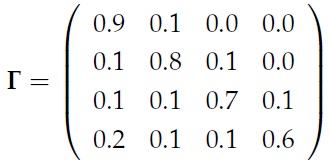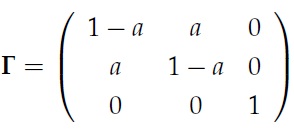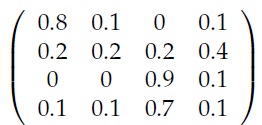1) Consider a Markov chain C1,C2, . . . .
(a) Prove that the joint probability of the first n steps is
p(C1, . . . ,Cn) = p(C1)π∏t=2p(Ct| Ct-1).
(b) Hence prove that, for any r < s < t p(Cr, Cs,Ct) = p(Cr) p(Cs|Cr) p(Ct | Cs).
(c) Hence prove that Cr and Ct are conditionally independent given Cs.
2) For an m-state Markov chain Ct with transition matrix G,
(a) prove that the marginal state probabilities at times t and t + 1 are related through
u(t + 1) = u(t) τ,
where u(t) is row vector (p(Ct = 1), . . . , p(Ct = m)).
(b) Hence prove that u(t + k) = u(t) τk (*)
for any integer k>=0.
(c) Under what conditions would (*) hold for k < 0?
3) For a general discrete homogenous Markov chain with transition matrix G and a specified initial distribution u(1), write an R function to do the following:
(a) compute the marginal distribution u(t) from t = 1 up to a specified time t = n
(b) plot the results.
• use operator %*% for matrix multiplication
• use rbind to collect vectors into rows of a matrix U
• use matplot(c(1:n),U,type="l") to plot them in a single plot.
Your R function should contain plenty of comments documenting its inputs, outputs and internal steps.
4) A discrete homogenous Markov chain has transition matrix

(a) Using your R function from Exercise 4, plot the marginal distribution u(t) for t = 1, . . . , 20, assuming the chain starts in state 1.
(b) Repeat part (a), assuming the chain starts in state 4.
(c) Deduce theoretically the stationary distribution δ of this chain.
(d) Compare your results from parts (a)–(c).
5) A discrete homogenous Markov chain has transition matrix

where 0 < a < 1.
(a) Show that δ= ( 1/3 , 1/3 , 1/3) is a stationary distribution of this Markov chain.
(b) Are there other stationary distributions of this chain?
(c) Comment on your conclusion.
6)a) Write an R function to generate a sequence of a given length from an m-state homogenous Markov chain with given transition matrix and initial state. As always, your code should contain plenty of comments. Hint: use sample(c(1:m), size=1, prob=p) to sample a single value from distribution p.
(b) Use this function to generate a sequence of length 100 from a Markov chain with initial state 1 and transition matrix

(c) From the resulting sequence, estimate the transition matrix, showing all working.
(d) Compare the true and estimated transition matrices.
7) (a) Write an R function to estimate the transition matrix of a discrete homogenous Markov chain from a given sequence of observations.
(b) Repeat Exercise E2.7b, this time generating a sequence of length 1000. For each value of k in 100, 200, . . . , 1000, estimate the transition matrix from only the first k observations, using your function from part (a).
(c) Plot these estimated transition matrices against k. Hint: use function matplot.
(d) Comment on your results.
8) N independent sequences, each of length n, are generated from a discrete homogenous Markov chain with transition matrix τ, with initial states drawn from an unknown distribution f .
(a) Write down the likelihood for such data.
(b) Derive the MLEs of f and τ.
(c) Comment on your results.